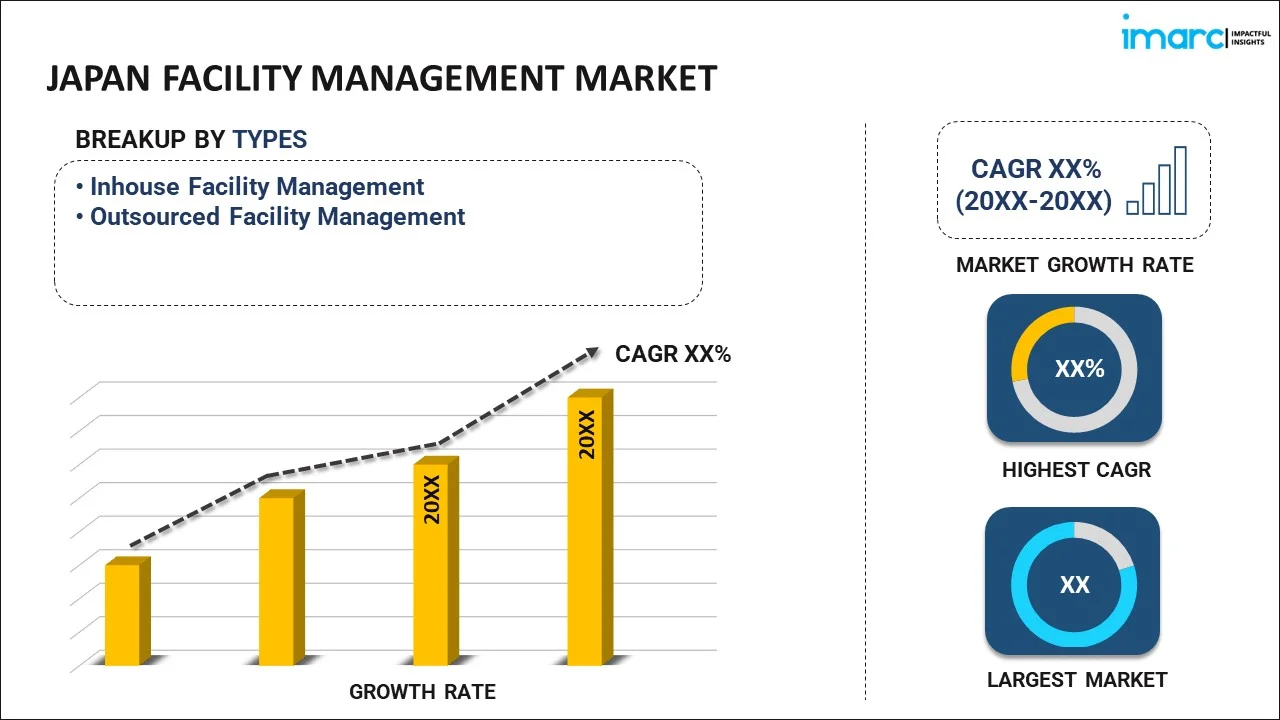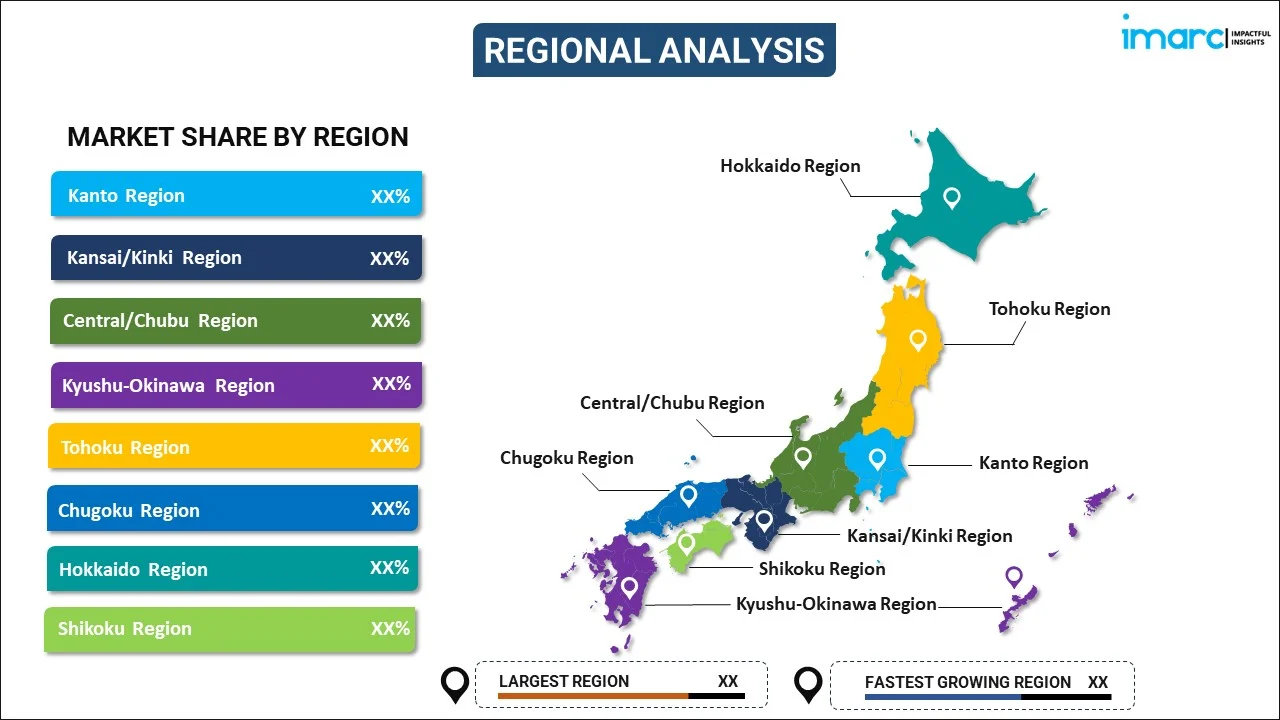
Japan Facility Management Market Report by Type (Inhouse Facility Management, Outsourced Facility Management), Offering (Hard FM, Soft FM), End User (Healthcare, Government, Education, Military and Defense, Real Estate, and Others), and Region 2025-2033
Market Overview:
Japan facility management market size reached USD 86,346 Million in 2024. Looking forward, IMARC Group expects the market to reach USD 165,779 Million by 2033, exhibiting a growth rate (CAGR) of 7.5% during 2025-2033. The growing demand for value-added services, such as space planning, occupancy management, sustainability consulting, workplace optimization, etc., that go beyond essential maintenance is primarily driving the market growth.
|
Report Attribute
|
Key Statistics
|
|---|---|
|
Base Year
|
2024
|
|
Forecast Years
|
2025-2033
|
|
Historical Years
|
2019-2024
|
| Market Size in 2024 | USD 86,346 Million |
| Market Forecast in 2033 | USD 165,779 Million |
| Market Growth Rate 2025-2033 | 7.5% |
Facility management is an interdisciplinary domain focused on the efficient maintenance and coordination of an organization’s physical assets, services, and infrastructure. It entails the amalgamation of people, processes, technology, and physical spaces to guarantee the seamless functioning and optimum efficacy of facilities. Individuals working in facility management oversee a variety of responsibilities such as planning of facilities, upkeep and repair, management of space, ensuring safety and security, managing energy, promoting environmental sustainability, and overseeing vendors. Their role is pivotal in establishing and sustaining secure, operational, and effective workspaces for employees and other stakeholders. Proficient facility management fosters enhanced productivity, monetary savings, reduction in risks, and improved user experiences. This domain requires strategic foresight, proper distribution of resources, and the employment of exemplary practices to synchronize facilities with the aims and objectives of an organization. It also encompasses adherence to regulations, initiatives for sustainability, and the incorporation of technology for automation and informed decision-making based on data.
Japan Facility Management Market Trends:
The Japan facility management industry is experiencing significant growth, driven by the surge in the utilization of smart building technologies. Additionally, smart buildings are incorporated with cutting-edge technologies like sensors, automation systems, and data analytics, thereby facilitating intelligent supervision and regulation of diverse building systems and services. Besides this, the advantages of these smart building solutions are manifold, including heightened energy efficiency, superior space optimization, augmented security and safety, and predictive maintenance capabilities, which is positively influencing the regional market. Moreover, professionals in facility management exploit such technologies to supervise and manage building functions remotely, pinpoint inefficiencies, and undertake proactive maintenance interventions. Apart from this, the amalgamation of facility management methodologies with smart building solutions facilitates the gathering and analysis of real-time data, enabling decisions based on solid data and the execution of anticipatory maintenance strategies. Such integrations contribute to a decrease in operational expenditures, improved comfort and health of occupants, and an increase in the longevity of building assets. Furthermore, with the continual evolution and tightening of regulatory frameworks, organizations are increasingly depending on facility management services to maintain compliance and minimize legal and financial vulnerabilities. This, in turn, is anticipated to bolster the regional market over the forecasted period.
Japan Facility Management Market Segmentation:
IMARC Group provides an analysis of the key trends in each segment of the market, along with forecasts at the country level for 2025-2033. Our report has categorized the market based on type, offering, and end user.
Type Insights:

- Inhouse Facility Management
- Outsourced Facility Management
- Single FM
- Bundled FM
- Integrated FM
The report has provided a detailed breakup and analysis of the market based on the type. This includes inhouse facility management and outsourced facility management (single FM, bundled, and FM integrated).
Offering Insights:
- Hard FM
- Soft FM
A detailed breakup and analysis of the market based on the offering have also been provided in the report. This includes hard FM and soft FM.
End User Insights:
- Healthcare
- Government
- Education
- Military and Defense
- Real Estate
- Others
The report has provided a detailed breakup and analysis of the market based on the end user. This includes healthcare, government, education, military and defense, real estate, and others.
Regional Insights:

- Kanto Region
- Kansai/Kinki Region
- Central/ Chubu Region
- Kyushu-Okinawa Region
- Tohoku Region
- Chugoku Region
- Hokkaido Region
- Shikoku Region
The report has also provided a comprehensive analysis of all the major regional markets, which include Kanto Region, Kansai/Kinki Region, Central/ Chubu Region, Kyushu-Okinawa Region, Tohoku Region, Chugoku Region, Hokkaido Region, and Shikoku Region.
Competitive Landscape:
The market research report has also provided a comprehensive analysis of the competitive landscape in the market. Competitive analysis such as market structure, key player positioning, top winning strategies, competitive dashboard, and company evaluation quadrant has been covered in the report. Also, detailed profiles of all major companies have been provided. Some of the key players include:
- CBRE Group Inc.
- Cushman & Wakefield plc
- ISS A/S
- Jones Lang LaSalle IP Inc.
- Nippon Kanzai Co. Ltd.
(Please note that this is only a partial list of the key players, and the complete list is provided in the report.)
Japan Facility Management Market Report Coverage:
| Report Features | Details |
|---|---|
| Base Year of the Analysis | 2024 |
| Historical Period | 2019-2024 |
| Forecast Period | 2025-2033 |
| Units | Million USD |
| Scope of the Report | Exploration of Historical and Forecast Trends, Industry Catalysts and Challenges, Segment-Wise Historical and Predictive Market Assessment:
|
| Types Covered |
|
| Offerings Covered | Hard FM, Soft FM |
| End Users Covered | Healthcare, Government, Education, Military and Defense, Real Estate, Others |
| Regions Covered | Kanto Region, Kansai/Kinki Region, Central/ Chubu Region, Kyushu-Okinawa Region, Tohoku Region, Chugoku Region, Hokkaido Region, Shikoku Region |
| Companies Covered | CBRE Group Inc., Cushman & Wakefield plc, ISS A/S, Jones Lang LaSalle IP Inc., Nippon Kanzai Co. Ltd., etc. |
| Customization Scope | 10% Free Customization |
| Post-Sale Analyst Support | 10-12 Weeks |
| Delivery Format | PDF and Excel through Email (We can also provide the editable version of the report in PPT/Word format on special request) |
Key Questions Answered in This Report:
- How has the Japan facility management market performed so far and how will it perform in the coming years?
- What has been the impact of COVID-19 on the Japan facility management market?
- What is the breakup of the Japan facility management market on the basis of type?
- What is the breakup of the Japan facility management market on the basis of offering?
- What is the breakup of the Japan facility management market on the basis of end user?
- What are the various stages in the value chain of the Japan facility management?
- What are the key driving factors and challenges in the Japan facility management?
- What is the structure of the Japan facility management market and who are the key players?
- What is the degree of competition in the Japan facility management market?
Key Benefits for Stakeholders:
- IMARC’s industry report offers a comprehensive quantitative analysis of various market segments, historical and current market trends, market forecasts, and dynamics of the Japan facility management market from 2019-2033.
- The research report provides the latest information on the market drivers, challenges, and opportunities in the Japan facility management market.
- Porter's five forces analysis assist stakeholders in assessing the impact of new entrants, competitive rivalry, supplier power, buyer power, and the threat of substitution. It helps stakeholders to analyze the level of competition within the Japan facility management industry and its attractiveness.
- Competitive landscape allows stakeholders to understand their competitive environment and provides an insight into the current positions of key players in the market.
Need more help?
- Speak to our experienced analysts for insights on the current market scenarios.
- Include additional segments and countries to customize the report as per your requirement.
- Gain an unparalleled competitive advantage in your domain by understanding how to utilize the report and positively impacting your operations and revenue.
- For further assistance, please connect with our analysts.
 Inquire Before Buying
Inquire Before Buying
 Speak to an Analyst
Speak to an Analyst
 Request Brochure
Request Brochure
 Request Customization
Request Customization




.webp)




.webp)












